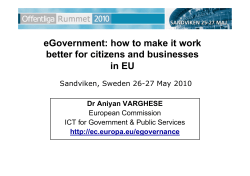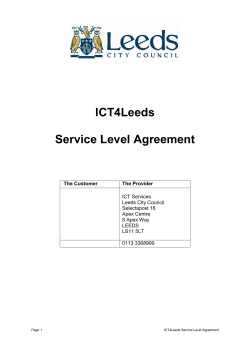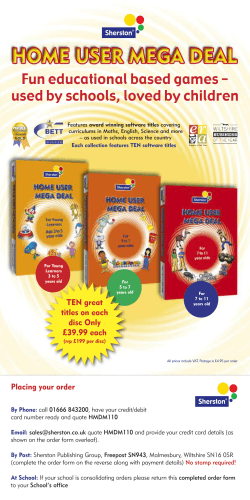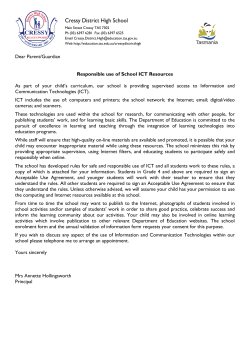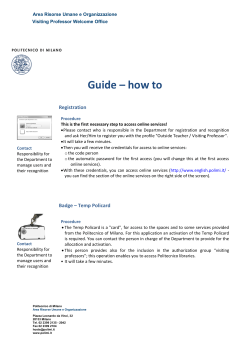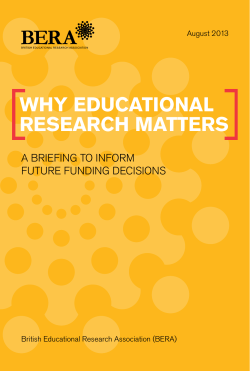
Document 212099
How to Prepare an ICT FP7 Proposal Eleni Christodoulou George Samaras University of Cyprus Success starts with a dream I have a dream! Building ICT Projects Traversing the Labyrinth Objectives: • Understanding how to apply to an ICT call for proposals • Explaining the steps and rules for preparing ICT proposals • To familiarize the participants with the project proposal structure • Providing the keys to find the right partners • Write a Successful Proposal • How to Successfully manage a Successful proposal Building ICT Projects Traversing the Labyrinth Topics Covered: • Steps for preparing ICT proposals • Find project partners • Key documents for proposals writing • Electronic Proposal Submission Service (EPSS) • ICT Proposal structure • Evaluation Process and Criteria • How to beat Evaluation Criteria • Proposal writing strategy • From the proposal to the project Building ICT Projects Traversing the Labyrinth 1. Steps for preparing ICT proposals 1. Identification of research areas in the ICT work programme 2. Find a Call in http://cordis.europa.eu/fp7 Cooperation supports all types of research activities carried out in trans-national cooperation and aiming leadership in key scientific and technology areas. Ideas Support frontier research People support for mobility and career development of researchers Capacities Enhance research and innovation capacities 3. Confirm that the funding mechanisms available are appropriate for your goals and restrictions Building ICT Projects Traversing the Labyrinth 1. Steps for preparing ICT proposals 4. Build a quality international consortium that: 1. Meets the minimum participation rules for the call for proposals 2. Has a mix of different types of organisations 3. Has the right mix of competencies and track record 4. Is complementary in terms of skills and perspective 5. Familiarise the consortium with specific guidance documentation and templates published by the European Commission for the targeted call for proposals 6. Draft a comprehensive proposal document following the Guide for Applicants 7. Submit the proposal to the European Commission. Building ICT Projects Traversing the Labyrinth 2. Find project partners Partner search facilities: Cordis Partners Service http://cordis.europa.eu/partners-service/ : • Publish your partners profile by entering your project idea or specific expertise • • • Search the Partners profiles submitted by other organizations Update or delete your existing profile on-line at any time Partners e-mail notification facility National Contact Points: • For general advice and for finding partners from other countries Ideal-ist project www.ideal-ist.net : • Provides a web-based platform for joining ICT projects and finding partners Your own Networking PRO-IDEAL project Ideal-ist project www.ideal-ist.net 1 2 PROPOSAL AT A GLANCE 3 PROJECT DESCRIPTION 4 5 PROPOSER INFORMATION http://www.ideal-ist.net Building ICT Projects Traversing the Labyrinth 3. Key documents Available at http://cordis.europa.eu/fp7/home_en.html • The call fiche • The work programme • FP7 factsheets - an overview of the basic features of this programme • The Guides for Applicants relevant to the funding schemes •Guide for applicants (Collaborative projects - Small and Medium-scale focused Research Projects - STREP) •Guide for Applicants (Collaborative projects: large scale Integrating Projects - IP) •Guide for applicants (Coordination Actions - CA) and ERA Net plus actions •Guide for applicants (Support Actions - SA) •Guide for applicants (Networks of Excellence - NoE) Building ICT Projects Traversing the Labyrinth 4. Submitting a proposal online - EPSS • Proposals must be submitted electronically, using the Commission's Electronic Proposal Submission Service (EPSS) • EPSS is an internet-based application providing a secure work space for a consortium to prepare and submit a proposal jointly • You can access the EPSS from the call page on CORDIS. Building ICT Projects Traversing the Labyrinth 4. Submitting a proposal online - EPSS Coordinators can: •register the proposal •set up (and modify) the consortium •complete all of Part A of the proposal • download document template for writing Part B • upload finished Part B •submit the complete proposal Part A and Part B Other participants can: •complete their own sections A2 (participant details) •download the document template for writing Part B •view the whole proposal Building ICT Projects Traversing the Labyrinth 5. Part A- the Forms (1) Building ICT Projects Getting through the Labyrinth 5. Part A- the Forms (2) Section A1: Summary • Proposal Acronym • Proposal Title • Duration in months • Call (part) identifier (e.g. FP7-ICT-2012-8) • Topic code(s) most relevant for the proposal • Free Keywords • Abstract (200 characters) Section A2: Participants • • • • • • • Participant number Participant Identification Code Legal name Organisation Short Name Legal address Organisation type Contact detail Section A3: Budget • Personnel costs • Subcontracting • Other direct costs • Indirect costs -Real indirect costs -Standard flat rate 20% -Flat rate 60% for SMEs, Research organisations, NGOs (until 2013) • Total budget • Requested EC contribution Participant Identification Code •Participants possessing an FP7 PIC can use this number to identify themselves in the EPSS. On entering the PIC, parts of the proposal forms will be filled in automatically •The process for assigning a PIC is triggered by a self-registration of an organisation at :http://ec.europa.eu/research/participants/urf •On this website you will also find a search tool for checking if your organisation is already registered (and thus already has a PIC) Building ICT Projects Getting through the Labyrinth 6. Part B - Contents Proposal abstract Section 1: Scientific and/or technical quality, relevant to the topics addressed by the call • 1.1 • • • 1.2 1.3 • • • • Concept and objectives Progress beyond the state-of-the-art S/T methodology and associated work plan i) Overall strategy of the work plan (Maximum length - one page) ii) Timing of the different WPs and their components (Gantt chart or similar). iii) Detailed work description broken down into work packages: • Work package list (table 1.3a); • Deliverables list (table 1.3b); • List of milestones (table 1.3c) • Description of each work package (table 1.3d) • Summary effort (table 1.3e) iv) Graphical presentation of the components (Pert diagram or similar) v) Significant risks, and associated contingency plans Building ICT Projects Getting through the Labyrinth 6. Part B - Contents Section 2. Implementation • • • • 2.1 Management structure and procedures (Maximum length for Section 2.1 - five pages) 2.2 Individual participants (Maximum length for Section 2.2: one page per participant) 2.3 Consortium as a whole (No maximum length for Section 2.3 – depends on the size and complexity of the consortium) 2.4 Resources to be committed (Maximum length for Section 2.4 - two pages) Section 3.Impact (Maximum length for the whole of Section 3 – ten pages) • • 3.1 Expected impacts listed in the work programme 3.2 Dissemination and/or exploitation of project results, and management of intellectual property Pre-proposal checks • Pre-proposal = short abstract of project idea • Pre-proposal check = feedback from Commission on eligibility of consortium, and whether the idea is in scope or not; does not pre-empt evaluation • Deadline for asking for pre-proposal check: three weeks before Call closing date • DigiCult mailbox: [email protected] Evaluation Criteria 7. Part C: Evaluation SCIENTIFIC & TCHNICAL QUALITY IMPLEMENTATION IMPACT Soundness of concept, quality of objectives, relevance to programme Management structure and Procedures Contribution to expected impact (see work programme) Progress beyond state of the art Quality, complementarity and balance of consortium and individual partners Measures for Quality and effectiveness of S/T methodology and work plan NoE: Contribution to longterm integration of high quality S/T research CSA: Quality and effectiveness of support or coordination Matching between consortium and proposal Objectives Appropriateness of allocation of resources -Dissemination -Exploitation of project results -IPR management -NoE: Spreading excellence and disseminating Knowledge through stakeholder & public engagement Scores & Thresholds SCIENTIFIC & TCHNICAL QUALITY 3/5 IMPLEMENTATION 3/5 Overall Threshold = 10 IMPACT 3/5 Proposal writing strategy Proposal Writing Plan Appoint proposal writer Write a 1-2 page proposal Circulate for comments Consortium meeting if necessary (distribution of work) Workpackages management Exploitation, etc. Compile proposal Review by “experts” Submit proposal Writing the Proposal • Divide your effort over the evaluation criteria! • Many proposers concentrate on the technology, and lose marks on the project planning (implementation) or impact description Writing the proposal Think of the finishing touches which signal quality work: • • • • clear language well-organised contents, following the Part B structure useful and understandable diagrams no typos, no inconsistencies, no obvious paste-ins, no numbers which don’t add up, no visible annotations or screwed-up diagrams, no missing pages … Writing the proposal • • • • • • Make it easy for the evaluators to give you high marks. Don’t make it hard for them! Make sure you submit the latest, complete version of your proposal Don’t write too little; cover what is requested Don’t write too much Don’t leave them to figure out why it’s good, tell them why it’s good Leave nothing to the imagination Writing the proposal Make sure your Project Workplan reflects the promises you made in the rest of your proposal. For example: •Good project management implies clear Workpackage leadership •Strong Impact implies an important dissemination effort Typical Project workplan (personmonths) WP1 WP2 P1 10 4 P2 2 2 WP3 WP4 WP6 4 2 2 P3 P4 WP5 2 18 2 3 12 12 12 3 2 2 P5 14 2 3 19 P6 5 2 11 18 28 P7 Total 12 18 23 8 35 6 6 8 104 The work package that does too much WP1 WP2 P1 10 4 P2 2 2 WP3 WP4 WP5 WP6 4 2 2 P3 2 18 2 12 3 3 2 2 12 28 P5 14 2 3 19 P6 5 2 11 18 P4 12 2 P7 Total 12 18 23 8 35 6 6 8 104 The partner who doesn’t know what to do WP1 WP2 P1 10 4 P2 2 2 WP3 WP4 WP5 WP6 4 2 2 P3 2 18 2 12 3 3 2 2 12 28 P5 14 2 3 19 P6 5 2 11 18 P4 12 2 P7 Total 12 18 23 8 35 6 6 8 104 The token SME WP1 WP2 P1 10 4 P2 2 2 WP3 WP4 WP5 WP6 4 2 2 P3 2 18 2 12 3 3 2 2 12 28 P5 14 2 3 19 P6 5 2 11 18 P4 12 2 P7 Total 12 18 23 8 35 6 6 8 104 …and new Member State WP1 WP2 P1 10 4 P2 2 2 WP3 WP4 WP5 WP6 4 2 2 P3 2 18 2 12 3 3 2 2 12 28 P5 14 2 3 19 P6 5 2 11 18 P4 12 2 P7 Total 12 18 23 8 35 6 6 8 104 The well-lead work packages which will get results WP1 WP2 P1 10 4 P2 2 2 WP3 WP4 2 2 2 18 2 12 3 3 2 2 12 28 P5 14 2 3 19 P6 5 2 11 18 P4 2 WP6 4 P3 12 WP5 P7 Total 12 18 23 8 35 6 6 8 104 Evaluation procedure • • • • • Individual reading by three or more experts Experts meet in “Consensus group” All experts in objective in Panel meeting Evaluation Summary Report (ESR) Commission selection of proposals for negotiation (respecting the budget and number limitations described in the Workprogramme) Building ICT Projects Getting through the Labyrinth 8. From the proposal to the project Proposal Submission Coordinator: EPSS submission before deadline Submit early, submit often! Eligibility Evaluation Negotiation by Experts Eligible EC: proposals are Check evaluated by eligibility independent criteria experts (2-3 months) Successful proposals enter into financial and technical negotiations with the EC stars (3-4 months) Project Starts Grant Agreement signed between the EC and the coordinator > the project officially (6-8 months after proposal submission) Negotiation of Projects • The selected proposers are invited to grant agreement negotiations • They are informed in advance of the available funding for the project, and of any technical changes required by the evaluators • The negotiations produce detailed cost forecasts and the “technical annex” ( Annex 1) to the grant agreement • The project begins work the month following the signing of the grant agreement Sources of information • FP7 activities: http://cordis.europa.eu/fp7/home_en.html CORDIS: The official entry point to Europe’s Seventh Framework Programme for research and technology development (FP7), its specific programmes, activities, themes and latest developments. • ICT Website http://cordis.europa.eu/fp7/ict/ brings together information on: - the FP7 ICT research programme and its objectives; - participating in ICT research under FP7 - including calls for proposals; - research and development projects carried out under FP7 and FP7; - the latest news on programme, projects and participation in the ICT Newsroom. Practical guide to EU funding opportunities for research and innovation. Rev 2 02/12/2008 http://cordis.europa.eu/eu-funding-guide/home_en.html FP7 National Contact Points: http://cordis.europa.eu/fp7/ncp_en.html FP7 Helpdesk: http://ec.europa.eu/research/index.cfm?pg=enquiries • • • Getting help with your proposal The Commission supports: • Information days and briefings in Brussels and elsewhere • A supporting website of advice, information and documentation: http://ec.europa.eu/ict_psp • Partner search facilities: http://www.ideal-ist.net/ Getting help with your proposal • An ICT PSP Helpdesk for proposers’ questions [email protected] • An EPSS helpdesk for system use tel: +32 2 233 3760 email [email protected] • A list of contact persons for the objectives in each call Getting help with your proposal • And a network of National Contact Points in Europe and beyond: http://ec.europa.eu/information_society/activ ities/ict_psp/contacts/index_en.htm ? s n o i t s e u Q THANK YOU! Material Selected from various Web Sources.
© Copyright 2024


